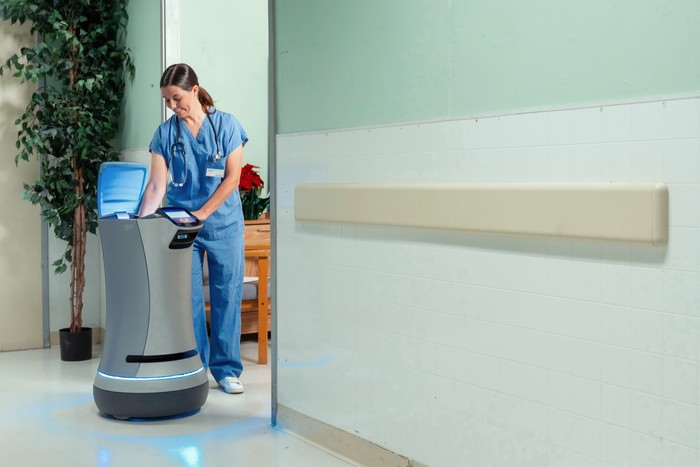Hospitals are using robots to clean and help provide care. Photography by Savioke.
Adventist Health White Memorial in Los Angeles uses a fleet of seven LightStrike robots from Xenex Disinfection Services to decontaminate rooms after patients vacate. Purchased in 2015, each robot can deploy multiple wavelengths of germ-killing UV rays — sanitizing a space in as little as 10 to 15 minutes without human contact — and wirelessly send confirmation to a secure, cloud-based portal.
“Our ER is very busy with a lot of admissions, so being able to turn our beds over quickly when someone leaves is important to us,” says Mara Bryant, an operations executive at Adventist Health. “The robot definitely helps make that happen.”
Will the arrival of 5G benefit robotic surgery for better healthcare delivery?
An Extra Set of Helping Hands
The machines, Bryant adds, also can decontaminate used N95 protective masks. That and other functions can offer peace of mind for busy clinicians and custodial staff.
“We find that they actually embrace the robot, and it makes them feel like they can accomplish that much more and provide that much more safety to the patients,” says Mark Stibich, co-founder and chief scientific officer at Xenex.
At MedStar Washington Hospital Center in Washington, D.C., a team of six Aethon TUG robots deliver linens and medicine across the 912-bed facility. Each robot can execute hundreds of tasks daily (collectively, they traveled 2,974 miles and completed 26,574 stops last year, according to the hospital).
Xenex Video Eliben from Newswise on Vimeo.
A system of sensors, lasers and waypoints from internally stored maps allow the TUG robots to navigate obstacles. A hospital’s central server controls their assignments and whereabouts, but the machines can navigate on their own — and even request an elevator ride en route to a destination.
That’s because they can memorize the location of reference points, similar to how humans might navigate their own homes in the middle of the night, says ST Engineering Aethon CEO Peter Seiff.
Robots Do Their Part as a Team Player
Hutchinson Health, a Level IV Trauma Center in Hutchinson, Minn., began using a Savioke Relay robot in 2018 to deliver blood samples between the main hospital lab and its onsite clinics.
Hutchinson’s robot, named Spencer (a nod to its job as a specimen dispenser), can work 24/7 and averages nearly 400 in-house deliveries per month. The machine is quicker and more cost-effective than delegating the task to an employee, according to a testimonial from the hospital.
Although the machine was purchased prior to the pandemic, it has since become helpful in reducing the risk of cross-contamination on container surfaces and in giving staff extra time to focus on other duties.










